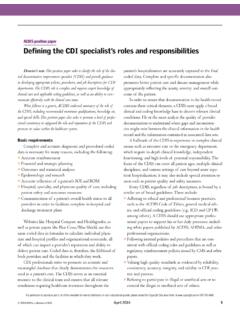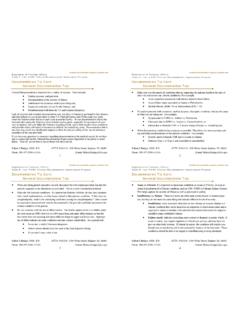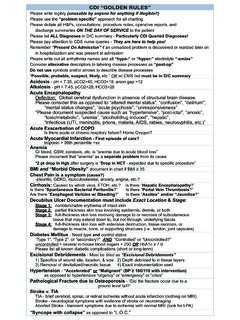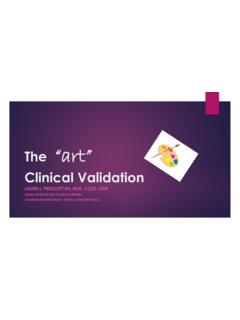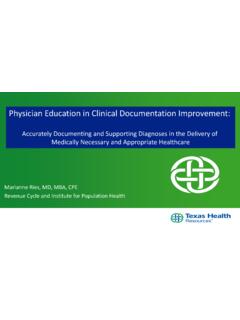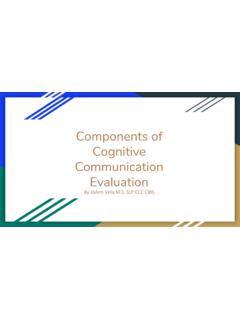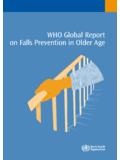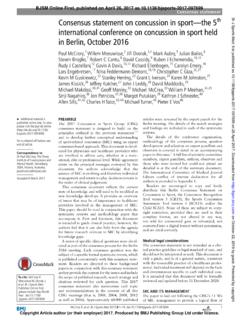Transcription of Clinical and Coding Conundrums - ACDIS
1 2016 HCPro, a division of BLR. All rights reserved. These materials may not be duplicated without express written D. Teague, MD, CCDS, SFHMA ssociate Medical Director Hospital Medicine, CDI Physician Advisor, AHIMA Approved ICD 10 CM/PCS TrainerOur Lady of the Lake Regional Medical CenterBaton Rouge, LAClinical and Coding Conundrums2 Clinical and Coding Conundrums3 Clinical and Coding Conundrums At the completion of this educational activity, the documentation specialist will be able to: Identify Clinical clues and indicators for complex medical conditions Discuss the importance of ensuring lesser reported diagnoses are supported in the record Describe query opportunities to facilitate accurate code capture for Respiratory failure following surgery Shock Encephalopathy ATN 2016 HCPro, a division of BLR. All rights reserved. These materials may not be duplicated without express written and Coding Conundrums68yo male smoker with hypertension presents c/o acute onset RUQ pain associated with intractable nausea and vomiting.
2 US + for cholecystitis and cholelithiasis. Pre op evaluation is notable for mild , stable dyspnea on exertion. 02 Sat, exam, CXR, and EKG are unremarkable. Patient undergoes laparoscopic cholecystectomy and is slow to awaken from anesthesia. After two hours his satsremain 90% on Venti mask associated with lethargy. The surgeon admits him to SICU and the intensivist is consulted. What might the intensivist document? 5 How Physicians Commonly Document This Condition Postop resp failureAcute resp failureHypoxemiaAcute resp insufficiencys/p cholecystectomyPost procedural respiratory failureWheezingAtelectasisLethargy6 Clinical and Coding Conundrums Clinical uncertainty especially within first 24h Asymptomatic patient Still under effects of anesthetics, opioids, and benzodiazepines A developing condition may not produce typical symptoms in this context Potential signs of acute resp failure may be related to anesthesia Routine support inherent to procedure ENT and thoracic surgery.
3 Expect some ventilator time 2016 HCPro, a division of BLR. All rights reserved. These materials may not be duplicated without express written Indicators of Acute Resp FailureImminentrespiratory arrestSevere respiratorydistressObjective criteria for acute resp failureClose monitoring and intensivetreatment Eyeball test AgitationRR > 28> 40% FI02 Depressed mental statusRetractions/use ofaccessory musclesp02 < 60 or > 10 below baseline p02 Noninvasive ventilation , BiPAPPoor respiratory effort, , he s getting tired Fragmented speechpC02 > 50 with pH < or 10 mmHg increase in baseline pC02 Invasive ventilation , intubationCyanosisDiaphoresis02 sats < 91% (if no baseline lung disease)Continuous pulse oximetryDusky skinDetermine most likely cause and initiate management, , steroids, Furosemide,MeropenemAhmed, A et al. Evaluation of the adult with dyspnea in the ED. In: UpToDate, Hockberger, RS (Ed), UpToDate, Waltham, MA. (Accessed 1/2016)8 Clinical and Coding ConundrumsPostop resp failure?
4 In MICU, the patient develops some mild wheezing which resolved with Albuterol nebs. He is soon extubated to nasal cannula @4 liters. Oxycodone is given for pain. He gradually becomes lethargic with RR 8. An ABG is obtained: pH , p02 59, pC02 65. BiPAP is started but the patient begins vomiting and urgent intubation is required. What might the intensivist document?9 Clinician Judgment and Coding Department Strategy Correct documentation and Coding Postop resp failure or postprocedural resp failure (MCC) Implies a surgical misadventure created the condition (+PSI) Meets criteria Acute resp failure with hypercapnia (MCC) Meets criteria Acute pulmonary/resp insufficiency following nonthoracic surgery (MCC) No guidelines for diagnosis. Pulmonologist survey consider it synonymous with resp failure. In practice .. less severe pulmonary issues. Patient doesn t meet criteria for resp failure, , no resp distress, mild hypoxemia corrects with 32% FIO2, wheezing, etc. Inadequate documentation and Coding Hypoxemia/hypoxia (not CC/MCC) Symptom code!
5 Will need clarification. Aspiration pneumonitis (MCC) Subsequent to respiratory decline and not primarily responsible. 2016 HCPro, a division of BLR. All rights reserved. These materials may not be duplicated without express written Happened in This Case? Patient remained on ventilator overnight Nebulizers administered Opioids and sedation withdrawn the next morning Patient extubated after an additional 8h on the ventilator Now has a headache! , acute postprocedural resp failure, coded at discharge11 More About Postop Resp FailureResp failure following trauma and surgery Coding Clinic Fourth Quarter 2011 Acute resp failure is a common postop complication Often requires mechanical ventilation > 48 hours after surgery Reintubation with mechanical ventilation after postop extubation Impaired gas exchange: Hypoxemia or hypercarbia Requires more than just supplemental oxygen or intensified observation Risk factors Specific to the patient s general health Trauma to chest wall can lead to inadequate gas exchange Type of anesthetic Incision near diaphragm12 Clinical and Coding ConundrumsPostprocedural resp failure: Who s at risk?
6 Plastic Reconstructive Surg. 2013 Nov; 132 (5) Validated Model for Predicting Postop Resp Failure: Analysis of 1,706 Abd Wall Reconstructions 6% developed postop resp failure Longer LOS and higher mortality rates 8 variables significantly associated with postop resp failure History of COPD Dyspnea at rest Dependent functional status Malnutrition Recurrent incarcerated hernia or concurrent intraabd. procedure ASA score > 3 (patient with severe systemic disease with constant threat to life) Prolonged operative time 2016 HCPro, a division of BLR. All rights reserved. These materials may not be duplicated without express written Resp Failure Is a PSI14 PSI 11 Has No Weight in PSI 90 Composite .. Yet15 Postprocedural Respiratory FailureWhat about the quality impact on surgeon and hospital? Patient Safety Indicator (PSI) Hospitals in lowest quartile receive 1% reduction in Medicare payment for fiscal year MCC .. significant impact on DRG Insurance denials .. considered inherent without additional resource use Physician public reporting Society Thoracic Surgery star ratings Includes time on vent after CABG (>24 hours considered prolonged and complication ) Propublica surgeon scorecard Administrative data on Medicare patients Risk adjusted: Mortality, readmissions, complications Surgeon assigned a low, medium, or high adjusted rate of complications American Board of Orthopedic Surgery announced data would affect board certification renewals Physician Compare 2016 HCPro, a division of BLR.
7 All rights reserved. These materials may not be duplicated without express written ExamplePatient presented with AAA and underwent operative repair. Postoperatively, patient was weaned from ventilator to venturi mask. He remained tachypneic with hypoxemic and an ABG showed: pH , pC02 and p02 of on FIO2 .50. After study, was the patient being treated for: Postoperative respiratory failure as complication of surgery Postoperative pulmonary insufficiency as complication of surgery Acute respiratory failure unrelated to surgery Acute respiratory insufficiency unrelated to surgery Other _____ No further specification can be providedQuery courtesy of Enjoin17 Clinical and Coding ConundrumsCirculatory shock Septic (MCC) Hypovolemic (MCC) Obstructive (MCC) Cardiogenic (MCC) Kills18 Clinical Indicators of Shock Systemic Hypotension: MAIN SIGN OF SHOCK Systolic BP <90 Mean Arterial Pressure (MAP) <70 Tachycardia Tissue Hypoperfusion Dermatologic: cold/clammy skin Renal: Oliguria (<30ml/hour) Neurologic: encephalopathy, delirium, obtundation Elevated Lactic Acid (>4mmol/L) 2016 HCPro, a division of BLR.
8 All rights reserved. These materials may not be duplicated without express written Hypotension vs. Shock Hypotension indicatorsShock indicatorsTransient Persistent without interventionMild or absence of symptoms , lucid, up in chair, eating breakfast, , , acute delirium, lethargic, cool extremities, chest painNormal urine outputReduced urine outputNormal lactic acid levelElevated lactic acid level (> 4mmol/L)Observed or offending medications not administeredRequires RBCs, IV antibiotics, pressors, steroids, ICU managementWalk from hospitalCarried out of hospital20 Types of ShockSeptic(distributive or vasogenic)HypovolemicObstructiveCardioge nicSepticBacterial, fungal, viral,parasiticHemorrhagicTrauma, GI bleed, postop, vaginalPulmonary vascular Large PE, severe pulmonary artery HtnCardiomyopathicMI, severe HF, stunnedmyocardium, myocarditisSIRSB urns, pancreatitis, traumaOther volume lossVomiting, diarrhea, heat stroke, third space lossesMechanicalTension pneumothorax, cardiac tamponadeArrhythmogenicAtrial or ventricularNeurogenicSpinal cord injury, traumatic brain injuryMechanicalSevere mitral or aortic valve disease, ruptured ventricular aneurysmAnaphylacticBee stings, food and drug allergiesGaieski, DF.
9 Definition, classification, etiology, and pathophysiology of shock in adults. In: UpToDate, Parsons PE (Ed), UpToDate, Waltham, MA. (Accessed 1/2016)21 Indications That Shock Was Treated VIPrule Ventilate: 02, intubate early Infuse rapidly Fluids with normal saline or lactated ringers Sepsis Core Measure (SEP 1) .. 30ml/kg bolus Albumin occasionally RBCs Pump (or Pressors) Norepinephrine Dopamine Dobutamine 2016 HCPro, a division of BLR. All rights reserved. These materials may not be duplicated without express written Hypotension Documented. Is a Query Needed for Shock?Physician thoughts: What is the baseline BP? Does the patient appear ill? Is there a condition present which might cause shock?23 Shock vs. HypotensionDoubt shock 77 yo male with chronic systolic failure (25% EF) s/p right femur fracture repair. SBP 82/40. Patient alert, conversant, asymptomatic. Lisinopril held. 29 yo female has intractable migraine with status migrainosus. SBP 79/55. Lethargic, in shock 56yomale s/p CABG.
10 POD #1. SBP 85, receiving 2 units RBCs for hemoglobin , on norepinephine. 52yofemale has right pneumonia with effusion. SBP 89, HR 107, mild delirium, given 2000 ml About Coding Postprocedural Shock? , postprocedural shock Shock during or resulting from a procedure, not elsewhere classified Something happened in the OR to create the condition Use of the term postop Complication must be clearly stated, cause/effect Query provider if any doubt Postprocedure shock unspecified (T8110XA) or postprocedure septic shock (T8112XA) result in a PSI. (postop sepsis 13) Risk adjusted Exclusions may apply , severe malnutrition, colon cancer 2016 HCPro, a division of BLR. All rights reserved. These materials may not be duplicated without express written About Coding Postprocedural Shock?Examples from Coding Clinic, Fourth Quarter 2011 Pages: 150 153 Question: The patient developed refractory cardiogenic shock that required temporary extracorporeal membrane oxygenation (ECMO) support after undergoing aortic valve replacement due to severe aortic stenosis.
